
Elswout is a historical buitenplaats (summer residence) dating from the 19th century in a park by the same name in Overveen, Netherlands.

Elswout is a historical buitenplaats (summer residence) dating from the 19th century in a park by the same name in Overveen, Netherlands.

The Elswout site was a buitenplaats for a long time before the current construction began. The original house (of which the structural wall's are incorporated in the current 19th century house) was built by a merchant dealing with Russia, called Carl du Moulin in circa 1633–1635. The design is attributed to Jacob van Campen and Pieter Post. After Du Moulin went bankrupt the estate was sold in 1654 to Gabriel Marselis, an Amsterdam arms merchant for the King of Denmark, who called the estate 'Elswout' (meaning: Alderwood). Like Du Moulin, he used it as a summer home while selling the sand to be shipped by boat to Amsterdam for construction. In the Frans Hals Museum 17th-century depictions of Elswout by Gerrit Berckheyde and Jan van der Heyden are on display.
By removing the sand in the dunes on his property, Gabriel Marselis was able to lay out a garden in the French style while financing this from the profits on the sand. Though the still existing "sand vaart" canal was originally constructed for Carl du Moulin, it is called the Marcelisvaart today after the rules that Marcelis drew up for the diggers and boatsmen on his property. [1] Removing sand from the property was only halted in 1948 when the level of the garden was considered dangerously low by the water board. [1]
In the years 1781-1794 the garden was redesigned in the English Landscape style by Mr. Jacob Boreel. During a short period afterwards Elswout was for rent, attracting Haarlem artists, who took their sketch books with them into the gardens. One of those artists was Egbert van Drielst. In 1805 the neglected estate was bought by the broker Willem Borski, who had close business relations with the Barings Bank and Hope & Co. After his death his widow Johanna Borski became not only the owner of Elswout, but also one of the most important bankers in Dutch history for co-founding and rescuing De Nederlandsche Bank in its early years. The main building seen today was designed in Italian high renaissance style in 1883 by C Muysken for her grandson, the rich banker Willem Borski III, but construction was stopped in 1884 when Borski died childless, and the house was never completed, remaining a folly until World War II when the German occupying forces put a provisional roof on the building for use as a garrison. [2]
The park surrounding the main house contains various follies that are also protected in the heritage register, as are the gatekeeper's entrance, the orangerie, and the stables. [2] Today there are plans to restore the building according to the original plans.
Today the park is open to the public and the Orangerie has a restaurant that can be rented for weddings and other events.

Het Loo Palace is a palace in Apeldoorn, Netherlands, built by the House of Orange-Nassau.

The City Hall in Haarlem is the seat of the city's government. It was built in the 14th century replacing the Count's castle.

The Hofje van Willem Heythuijsen is a hofje in Haarlem, Netherlands. It was founded in 1650 by the testament of Willem van Heythuysen on the site of his summer residence outside the city walls of Haarlem on land that was considered Heemstede property until it was annexed in 1927. It is one of the few hofjes of Haarlem to be built outside the city walls. It has a 'T' shape and has a small open courtyard and a garden still intact.
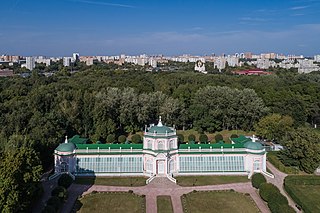
An orangery or orangerie was a room or a dedicated building on the grounds of fashionable residences of Northern Europe from the 17th to the 19th centuries where orange and other fruit trees were protected during the winter, as a very large form of greenhouse or conservatory.
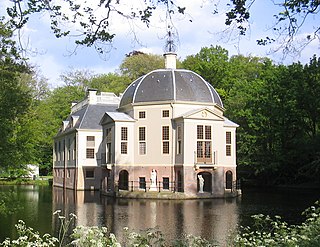
Trompenburgh is a 17th-century manor house in 's-Graveland, the Netherlands, designed by Daniël Stalpaert and built for Admiral Cornelis Tromp, one of the naval heroes of the Dutch Republic. The house is almost entirely surrounded by water and was built to resemble a ship, even with decks and railings.

Villa Welgelegen is a historical building in Haarlem, the Netherlands, which currently houses the offices of the provincial executives of North Holland. Located at the north end of a public park in the city, it is an example of neoclassical architecture, designed by Abraham van der Hart and unusual for its style in the Netherlands.

A buitenplaats was a summer residence for rich townspeople in the Netherlands. During the Dutch Golden Age of the 17th century, many traders and city administrators in Dutch towns became very wealthy. Many of them bought country estates, at first mainly to collect rents, however soon mansions started to be built there, which were used only during the summer.

Hartekamp, or Hartecamp, is the name of a villa in Heemstede, North Holland, the Netherlands, on the Bennebroek border. It was once the Buitenplaats of George Clifford, who employed Carl Linnaeus in 1737 to write his Hortus Cliffortianus, a detailed description of the gardens of Hartecamp.

Gerrit Adriaenszoon Berckheyde was a Dutch Golden Age painter, active in Haarlem, Amsterdam, and The Hague, who is best known today for his cityscapes.
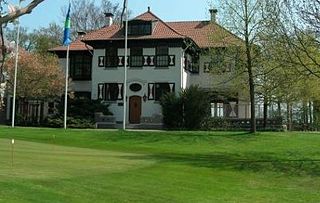
De Poll, formerly De Pol, is an estate at Pollselaan 5 south of Glimmen in the municipality of Groningen, Netherlands. The estate is located in the valley of the Drentsche Aa. The golf course of the Noord-Nederlandse Golf & Country Club has been located on the estate since 1953. The estate is covered by the Dutch 'Natural Beauty Act' (Natuurschoonwet) of 1928 that provides tax benefits to owners, usufructuaries and leaseholders of country estates.
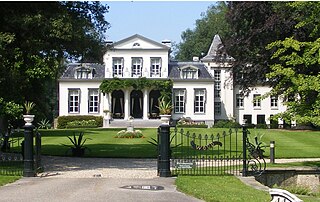
Oranjewoud is a small village in the Netherlands. It is located in the municipality of Heerenveen, Friesland. Oranjewoud had a population of 1570 in January 2017. It is known for Oranjewoud Palace.

The KattenKabinet is an art museum in Amsterdam devoted to works depicting cats. The museum collection includes paintings, drawings, sculptures and other works of art by Pablo Picasso, Rembrandt, Henri de Toulouse-Lautrec, Corneille, Sal Meijer, Théophile Steinlen, and Jože Ciuha, among others.

Beeckestijn is a historical buitenplaats dating from the 18th century in a park by the same name in Velsen-Zuid, Netherlands.
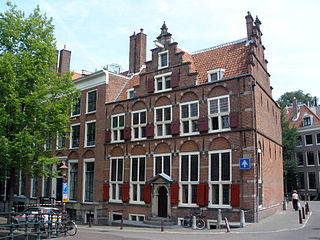
The Huis aan de Drie Grachten or Huis op de Drie Grachten is a 17th-century canal house in Amsterdam, at the southeastern end of the Wallen district. The name is a reference to the fact that the building faces three different Amsterdam canals. The south facade faces Grimburgwal, the west facade faces Oudezijds Voorburgwal and the east facade faces Oudezijds Achterburgwal. The address is Oudezijds Voorburgwal 249.

Gunterstein Castle is a castle in Breukelen, on the river Vecht, that was the former home of the rich Dutch widow Magdalena Poulle (1626–1699). She bought the property and associated title after the former castle and stronghold was destroyed by the French in the Disaster Year Rampjaar 1672.

Iepenrode, or Ipenrode, is the name of a villa in Heemstede, the Netherlands, between the Leidsevaart and Herenweg, located north of Huis te Manpad and south of Berkenrode. It was once the summer home of various mayors (burgemeesters) of Haarlem and is currently privately owned.

The Waag (Waegh) is a former Weigh house in Haarlem that today serves as a café catering to tourists.
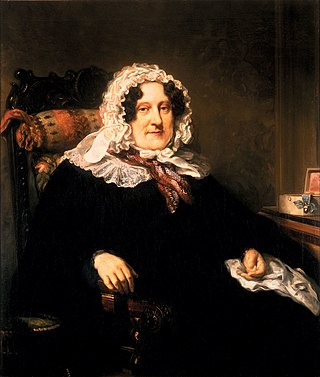
Johanna Borski (1764–1846), was an influential Dutch banker. She was the director of the "Wed. Borski" bank from 1814 to 1846. In 2022 Borski was in the news with regard to whether her wealth was due to slavery.

Kraantje Lek is a pancake restaurant and former inn in Overveen, Netherlands, on the Duinlustweg.
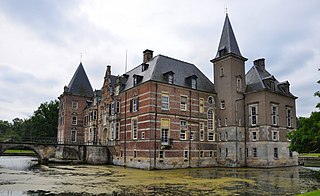
Twickel is a protected historic country estate with 81 complex parts near Delden in the hamlet of Deldeneresch, in the municipality of Hof van Twente in the province of Overijssel in The Netherlands. The moated castle forms the center.